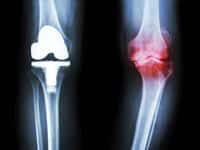Arthritis can severely damage the cartilage and bone in the knee joint, resulting in pain, stiffness, and difficulty with your everyday activities. In many cases, arthritis is initially treated withnonsurgical methods. However, if nonsurgical treatments fail to relieve knee pain and restore function, surgery may be recommended.
Total knee replacement involves replacing the damaged portions of the knee joint with implants designed to recreate a normal, healthy knee.
Anatomy of the Knee
The knee is made up of three bones: the lower end of the thighbone, the upper end of the shinbone, and the kneecap. Ligaments hold the joint together to provide stability. Cartilage covers the bones to provide a smooth surface and allow the joint to move easily. C-shaped wedges called menisci are located in the center of the joint, between the thighbone and shinbone, to absorb shock.
Arthritis and injury can damage the cartilage or cause it to wear away over time, leading to pain, stiffness, and possible loss of function. A total knee replacement can help to relieve pain and restore function in the knee.
Candidates for Total Knee Replacement
Patients generally undergo nonsurgical treatment before opting for surgery. Nonsurgical treatment can include anti-inflammatory medications, injections, or physical therapy. Patients who do not find relief from nonsurgical treatment may be candidates for surgery.
Candidates for total knee replacement have pain and stiffness in the knee that limits daily activities. It may be difficult to climb stairs, stand up and sit down, or even walk without assistance. Pain often gets worse with activity, but some patients also have pain while at rest. In more severe cases, the knee can even become deformed.
Total Knee Replacement Procedure
During a total knee replacement, the damaged cartilage and bone in the knee joint is replaced with prosthetic components.
First, the damaged cartilage, along with a small amount of bone underneath, is removed to make room for the implants. Metal implants are then positioned into the bone to help recreate the joint. In some cases, the kneecap may also be trimmed and resurfaced with a plastic button. A plastic spacer is inserted between the two metal components to create a smooth surface for the implants when moving the knee.
Recovery And Outcome
After surgery, you will likely need to stay in the hospital overnight and may typically return home the day after surgery. Physical therapy and exercise is critical to the success of your knee replacement. In many cases, patients begin working with a physical therapist in the hospital the day after surgery. You may be given pain medication to manage your pain so that you are able to participate in physical therapy.
It is important to begin moving the new knee joint as soon as possible after surgery to prevent stiffness. Your physical therapist will work with you to gradually begin walking and putting weight on the knee after surgery. Most patients are able to return to normal activities within 3 to 6 weeks of surgery.
For the vast majority of patients, total knee replacement is very successful in relieving knee pain, allowing patients to return to their normal activities. However, a knee replacement will not allow you to do more than you could before you had knee pain.
Total Knee Replacement In Terre Haute And Fort Wayne, IN
Dr. Meneghini specializes in total knee replacement techniques, and was selected as the Castle Connelly Indianapolis “Top Doctor” in 2022. He is committed to providing the highest quality care and best outcomes possible. If you would like to learn more about total knee replacement or schedule an appointment with Dr. Meneghini, please call our office at (317) 620-0232.

Specialties
